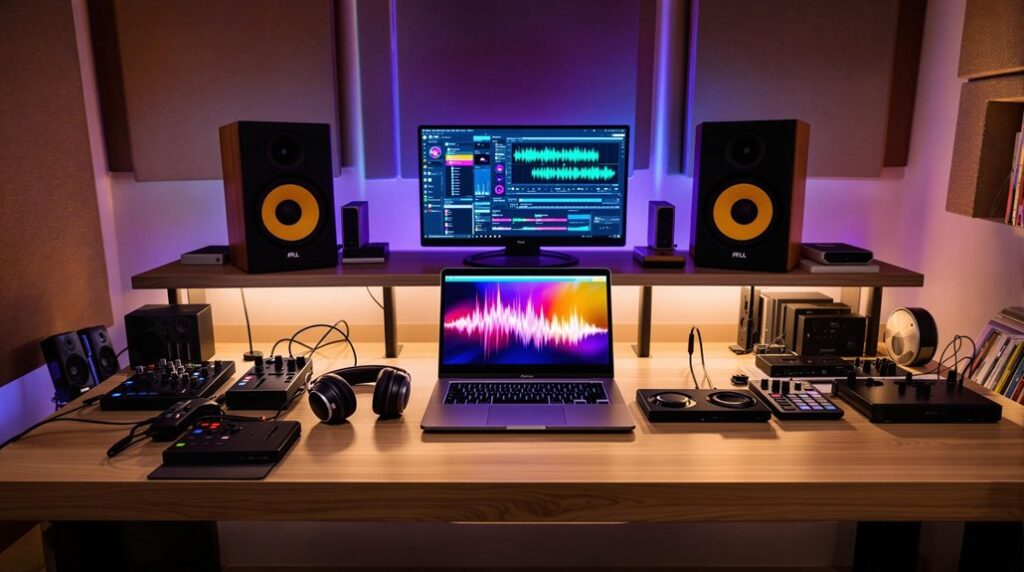To collaborate with a professional mix engineer, start with an initial consultation to discuss your project’s vision and expectations. Prepare your tracks by cleaning up audio, organizing, and labeling them properly. Deliver files in high-quality formats like WAV or AIFF, following the engineer’s specs. Share reference tracks that convey your desired sound. Maintain clear communication during the mixing process for progress updates and feedback. Review the first mix for balance, clarity, and dynamics. Provide specific feedback for revisions and make sure all adjustments are made before final approval. This guarantees your music achieves its intended quality and impact. Discover more intricacies of this collaborative process ahead.
Key Takeaways
- Establish clear communication by discussing project goals, preferences, and expectations upfront.
- Prepare and organize high-quality, clearly labeled audio tracks for delivery in the specified format.
- Provide 1-3 reference tracks to convey your desired sound and style.
- Schedule regular check-ins for progress updates and detailed feedback.
- Conduct a thorough review of the first mix and provide specific, constructive feedback for revisions.
Initial Consultation
In the initial consultation with your mix engineer, you’ll discuss project details, goals, and expectations to establish a clear vision for the mixing process. This meeting is vital for setting consultation expectations and ensuring both parties are aligned.
Discussing file formats, deadlines, revisions, and preferred communication methods will help to iron out logistical details early on.
Providing reference tracks, rough mixes, and any specific requirements is essential. These materials give the mix engineer a thorough understanding of your sonic preferences and the direction you want your project to take.
During this time, focus on establishing rapport with your mix engineer. Building a professional relationship based on trust and clear communication will facilitate a smoother collaboration.
You’ll need to be specific about your goals and any particular elements you want to highlight or minimize in the mix. This level of detail helps the mix engineer tailor their approach to your project’s unique needs.
Preparing Your Tracks
After your initial consultation, you’ll need to focus on preparing your tracks to guarantee a smooth and efficient mixing process. Proper track organization and attention to sound quality are important to make sure the mix engineer can work effectively.
Start by cleaning up your audio tracks, removing any background noise and unwanted artifacts. This step is essential for maintaining high sound quality and providing a clear canvas for the mix engineer.
Next, balance your processed and unprocessed tracks in the rough mix. This helps the mix engineer understand your intended sound and desired processing. Always provide detailed notes on any special effects or specific requirements you have for the tracks. Clear communication will streamline the mixing process.
Consider these key steps:
- Track Cleanup: Remove any background noise and unwanted artifacts to ensure high sound quality.
- Track Organization: Label tracks clearly and organize them logically to help the mix engineer navigate your project easily.
- Rough Mix Balance: Balance processed and unprocessed tracks to give a clear idea of your desired sound.
File Delivery
When preparing your files for delivery, make sure each track is properly named and organized.
Export your tracks in the required format, such as WAV or AIFF, with the specified bit depth and sample rate.
Provide clear instructions and a rough mix for reference, then compress everything into a zip folder for efficient transfer.
File Format Requirements
Mix engineers often request specific file formats like WAV or AIFF to guarantee the highest quality during the mixing process. These formats are uncompressed and preserve the original audio fidelity, making them ideal for professional mixing.
When preparing your files, it’s essential to adhere to the mix engineer’s specifications to avoid any degradation in sound quality.
To guarantee seamless collaboration, consider the following technical details:
- Compression settings: Avoid using compressed formats like MP3. Compressed files can lead to loss of data and lower audio quality, which hinders the mixing process.
- Bit depth limitations: Typically, mix engineers prefer files with a bit depth of 24-bit or higher. This bit depth captures more detail in the audio, providing greater dynamic range and headroom for mixing.
- Sample rate: Make sure your files are at the sample rate requested by the mix engineer, usually 44.1kHz or 48kHz. This consistency avoids resampling issues that can introduce artifacts.
Naming Conventions Explained
Proper naming conventions for your audio files streamline the mix engineer’s workflow and minimize the risk of errors during the mixing process. Start by naming tracks logically with sequential numbers, such as ’01_Kick,’ ’02_Snare,’ and ’03_HiHat.’ This approach aids in track organization and easy import, ensuring that your mix engineer can quickly identify and manage each element.
For effective file management, avoid using excessive plugins during file preparation. This preserves the sound quality of your tracks and allows the mix engineer to apply their preferred processing techniques. Additionally, remove any automation and add fades to guarantee smooth adjustments and prevent clicks or pops during playback.
Consistency is key when exporting tracks. Make sure all files share the same start and end points, which simplifies synchronization. Consider providing DI tracks for guitars and bass, as some engineers prefer the flexibility to re-amp or apply different effects during mixing.
Properly edited and in-time vocals are essential. This allows the mix engineer to focus on enhancing the overall sound rather than correcting timing issues. Following these naming conventions and file preparation guidelines will result in a more efficient and productive mixing process.
Providing References
When working with a mix engineer, providing 1-3 reference tracks is essential for conveying your preferred sound and style. These references help the engineer understand your artistic inspirations and the specific sonic qualities you’re aiming for.
Clear reference tracks guarantee the final mix meets your expectations for instrument balance, effects, and overall vibe.
Preferred Sound Examples
Providing 1-3 reference songs helps your mix engineer grasp the specific tonal and spatial preferences you’re aiming for in the final mix. These references are invaluable for communicating your sound preferences and genre influences, ensuring that your creative vision and sonic direction are clearly understood.
Here’s how to make the most out of providing preferred sound examples:
- Select Tracks with Similar Genre Influences: Choose reference songs within the same genre or sub-genre as your track. This gives the mix engineer a solid foundation for understanding the typical sound characteristics and production techniques used.
- Highlight Specific Elements: Point out particular instruments or vocal effects in the reference tracks that you want to emulate. Whether it’s the punch of the drums, the clarity of the vocals, or the warmth of the bass, specificity helps the engineer focus on what’s most important to you.
- Provide a Rough Mix: If you have a rough mix of your song, share it alongside your references. This combination offers a detailed guide for the mix engineer, illustrating both the general feel and the precise details you’re looking for.
Artist Inspirations
To ensure your mix engineer fully grasps the artistic influences behind your music, share 1-3 reference songs that encapsulate the style, mood, and production elements you aspire to achieve. Providing these musical influences is essential because it helps convey your creative direction clearly and concisely. By having reference tracks, your mix engineer can better understand the sonic landscape you envision, aligning their work with your artistic goals.
| Reference Aspect | Detail | |
|---|---|---|
| Aspect | Focus Area | Questions to Reflect on |
| Balance | Levels | Are any instruments too loud or too soft? |
| Clarity | Frequency Range | Are all elements clear and distinct? |
| Dynamics | Compression | Is the mix too compressed or too dynamic? |
| Panning | Stereo Field | Is the stereo image balanced and natural? |
| Effects | Reverb/Delay | Are the effects enhancing or cluttering? |
Effective communication is key. Be precise and specific in your comments. Instead of saying, ‘The vocals don’t stand out,’ say, ‘The vocals need a bit more presence around 2-3 kHz.’ This clarity sets the tone for the rest of the mixing process and ensures a collaborative and productive relationship with your mix engineer.
Revisions and Feedback
Once you’ve completed the first mix review, the next step involves providing detailed revisions and feedback to fine-tune the mix to your satisfaction. Your input is vital at this stage to guide the mix engineer in making the necessary mix adjustments.
Be as specific as possible about what you like or dislike. This will help in refining the mix to achieve the desired sound.
Open communication and constructive criticism are key to successful revisions. Here are some tips to effectively communicate your feedback:
- Be Specific: Mention exact timestamps where changes are needed, such as ‘The vocals at 1:25 need to be louder.’
- Prioritize Issues: List the most critical mix adjustments first to make sure the primary elements are addressed.
- Provide Context: Explain why certain changes are needed, like ‘The bass feels too overpowering and drowns out the kick drum.’
Final Approval
Before you give final approval, review the mix thoroughly to confirm that all your adjustments and feedback have been accurately implemented. This is an important step in ensuring client satisfaction and maintaining high standards of quality control.
Listen to the mix on various playback systems to check for consistency and balance. Pay attention to details such as volume levels, EQ, and effects placement.
Clear communication with your mix engineer is essential during this phase. Provide detailed feedback on any remaining issues and make sure that all revisions are addressed before you sign off on the final version. This step isn’t just about minor tweaks; it verifies that the mix meets your artistic vision and technical standards.
Final approval signifies that the mix is ready for mastering and distribution. It’s essential to confirm your satisfaction with the mix to avoid unnecessary revisions later. Once you’re confident that the mix is perfect, communicate your approval to the mix engineer.
This final step in quality control ensures that the project progresses smoothly to the next phase, whether that’s mastering, distribution, or release. By meticulously reviewing the mix, you ensure the highest level of client satisfaction and project success.
Frequently Asked Questions
What Are the Responsibilities of a Mixing Engineer?
You’ll oversee sound balancing and frequency adjustments to achieve a polished final product. Guarantee consistency across playback systems, apply effects, and enhance overall sound quality. Use specialized equipment and techniques to raise the music’s quality.
What Do You Send to a Mixing Engineer?
You should send well-edited audio tracks in the correct file formats. Include track labeling for clarity, and provide detailed notes on desired effects. Balance processed and unprocessed tracks, and consider sending stems or consolidated audio files.
How Much Does a Professional Mixing Engineer Cost?
Professional mixing engineer costs vary widely based on industry rates. You can expect to pay between $300 and $3000 per song. Budget considerations include the engineer’s reputation, project complexity, and whether you’re opting for package deals.
How Long Does It Take to Be a Mixing Engineer?
It typically takes several years to become a mixing engineer. You’ll need to follow educational pathways like a degree in music production and gain practical experience through apprenticeships or assistant roles in studios.
Conclusion
Working with a professional mix engineer requires clear communication and meticulous preparation. By following steps like an initial consultation, proper file delivery, and providing references, you guarantee a smooth process.
Actively engage during the mix review and provide constructive feedback for revisions. Your involvement is essential for achieving the final mix that meets your vision.
Ultimately, this collaborative effort results in a polished, professional sound that enhances your music’s potential.




